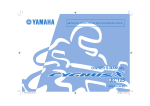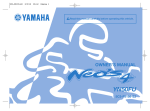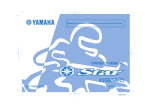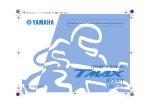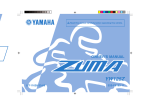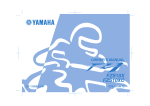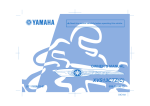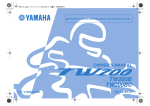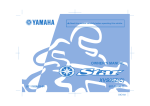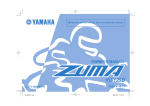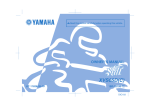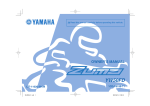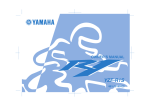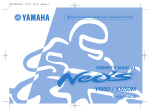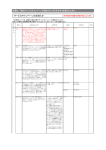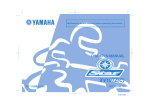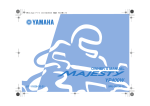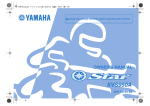Download periodic maintenance and adjustment
Transcript
Read this manual carefully before operating this vehicle. OWNER’S MANUAL XC125E 4P7-F8199-E2 DIC183 U4P7E2E0.book Page 1 Thursday, August 20, 2009 9:44 AM EAU46090 Read this manual carefully before operating this vehicle. This manual should stay with this vehicle if it is sold. U4P7E2E0.book Page 1 Thursday, August 20, 2009 9:44 AM INTRODUCTION EAU10113 Welcome to the Yamaha world of motorcycling! As the owner of the XC125E, you are benefiting from Yamaha’s vast experience and newest technology regarding the design and manufacture of high-quality products, which have earned Yamaha a reputation for dependability. Please take the time to read this manual thoroughly, so as to enjoy all advantages of your XC125E. The Owner’s Manual does not only instruct you in how to operate, inspect and maintain your scooter, but also in how to safeguard yourself and others from trouble and injury. In addition, the many tips given in this manual will help keep your scooter in the best possible condition. If you have any further questions, do not hesitate to contact your Yamaha dealer. The Yamaha team wishes you many safe and pleasant rides. So, remember to put safety first! Yamaha continually seeks advancements in product design and quality. Therefore, while this manual contains the most current product information available at the time of printing, there may be minor discrepancies between your scooter and this manual. If there is any question concerning this manual, please consult a Yamaha dealer. EWA12411 WARNING Please read this manual carefully and completely before operating this scooter. U4P7E2E0.book Page 1 Thursday, August 20, 2009 9:44 AM IMPORTANT MANUAL INFORMATION EAU10132 Particularly important information is distinguished in this manual by the following notations: This is the safety alert symbol. It is used to alert you to potential personal injury hazards. Obey all safety messages that follow this symbol to avoid possible injury or death. WARNING NOTICE TIP A WARNING indicates a hazardous situation which, if not avoided, could result in death or serious injury. A NOTICE indicates special precautions that must be taken to avoid damage to the vehicle or other property. A TIP provides key information to make procedures easier or clearer. U4P7E2E0.book Page 2 Thursday, August 20, 2009 9:44 AM IMPORTANT MANUAL INFORMATION EAU37230 XC125E OWNER’S MANUAL ©2009 by Yamaha Motor Co., Ltd. 1st edition, July 2009 All rights reserved. Any reprinting or unauthorized use without the written permission of Yamaha Motor Co., Ltd. is expressly prohibited. Printed in China. U4P7E2E0.book Page 1 Thursday, August 20, 2009 9:44 AM TABLE OF CONTENTS SAFETY INFORMATION ..................1-1 Further safe-riding points ................1-5 FOR YOUR SAFETY – PRE-OPERATION CHECKS ............. 4-1 DESCRIPTION ..................................2-1 Left view ..........................................2-1 Right view ........................................2-2 Controls and instruments.................2-3 OPERATION AND IMPORTANT RIDING POINTS................................. 5-1 Starting the engine ......................... 5-1 Starting off ...................................... 5-2 Acceleration and deceleration ........ 5-2 Braking ........................................... 5-3 Tips for reducing fuel consumption ............................... 5-3 Engine break-in .............................. 5-4 Parking ........................................... 5-4 INSTRUMENT AND CONTROL FUNCTIONS .......................................3-1 Main switch/steering lock ................3-1 Keyhole cover .................................3-2 Indicator, indicator lights and warning light ................................3-2 Speedometer unit ...........................3-3 Self-diagnosis device ......................3-4 Fuel gauge ......................................3-4 Anti-theft alarm (optional) ...............3-4 Handlebar switches ........................3-5 Front brake lever ............................3-5 Rear brake lever .............................3-6 Fuel tank cap ..................................3-6 Fuel .................................................3-7 Catalytic converters ........................3-8 Seat ................................................3-8 Helmet holders ...............................3-9 Storage compartments .................3-10 Carrier ...........................................3-11 Luggage hook ...............................3-11 Sidestand ......................................3-11 Ignition circuit cut-off system ........3-12 PERIODIC MAINTENANCE AND ADJUSTMENT ................................... 6-1 Periodic maintenance chart for the emission control system ....... 6-2 General maintenance and lubrication chart .......................... 6-3 Removing and installing cowlings and panels .................................. 6-6 Checking the spark plug ................. 6-8 Engine oil ....................................... 6-9 Final transmission oil .................... 6-11 Air filter and V-belt case air filter elements ................................... 6-12 Checking the throttle cable free play ........................................... 6-14 Valve clearance ............................ 6-15 Tires ............................................. 6-15 Cast wheels ................................. 6-17 Checking the front brake lever free play .................................... 6-17 Adjusting the rear brake lever free play .................................... 6-17 Checking the front brake pads and rear brake shoes ............... 6-18 Checking the front brake fluid level .......................................... 6-19 Changing the brake fluid .............. 6-20 Checking and lubricating the cables ................................. 6-20 Checking and lubricating the throttle grip and cable ......... 6-20 Lubricating the front and rear brake levers .............................. 6-21 Checking and lubricating the centerstand and sidestand ....... 6-21 Checking the front fork ................. 6-22 Checking the steering .................. 6-23 Checking the wheel bearings ....... 6-23 Battery ......................................... 6-23 Replacing the fuse ....................... 6-25 Replacing the headlight bulb ....... 6-25 Replacing a front turn signal light bulb ........................................... 6-26 Rear turn signal light and tail/brake light ........................................... 6-27 Replacing the auxiliary light bulb ........................................... 6-27 Troubleshooting ........................... 6-28 U4P7E2E0.book Page 2 Thursday, August 20, 2009 9:44 AM TABLE OF CONTENTS Troubleshooting chart ...................6-29 SCOOTER CARE AND STORAGE ...7-1 Matte color caution .........................7-1 Care ................................................7-1 Storage ...........................................7-3 SPECIFICATIONS .............................8-1 CONSUMER INFORMATION.............9-1 Identification numbers ....................9-1 U4P7E2E0.book Page 1 Thursday, August 20, 2009 9:44 AM SAFETY INFORMATION EAU10264 1 Be a Responsible Owner As the vehicle’s owner, you are responsible for the safe and proper operation of your scooter. Scooters are single-track vehicles. Their safe use and operation are dependent upon the use of proper riding techniques as well as the expertise of the operator. Every operator should know the following requirements before riding this scooter. He or she should: ● Obtain thorough instructions from a competent source on all aspects of scooter operation. ● Observe the warnings and maintenance requirements in this Owner’s Manual. ● Obtain qualified training in safe and proper riding techniques. ● Obtain professional technical service as indicated in this Owner’s Manual and/or when made necessary by mechanical conditions. Safe Riding Perform the pre-operation checks each time you use the vehicle to make sure it is in safe operating condition. Failure to inspect or maintain the vehicle properly increases the possibility of an accident or equipment damage. See page 4-1 for a list of pre-operation checks. ● This scooter is designed to carry the operator and a passenger. ● The failure of motorists to detect and recognize scooters in traffic is the predominating cause of automobile/scooter accidents. Many accidents have been caused by an automobile driver who did not see the scooter. Making yourself conspicuous appears to be very effective in reducing the chance of this type of accident. Therefore: • Wear a brightly colored jacket. • Use extra caution when you are approaching and passing through intersections, since intersections are the most likely places for scooter accidents to occur. 1-1 ● ● • Ride where other motorists can see you. Avoid riding in another motorist’s blind spot. Many accidents involve inexperienced operators. In fact, many operators who have been involved in accidents do not even have a current driver’s license. • Make sure that you are qualified and that you only lend your scooter to other qualified operators. • Know your skills and limits. Staying within your limits may help you to avoid an accident. • We recommend that you practice riding your scooter where there is no traffic until you have become thoroughly familiar with the scooter and all of its controls. Many accidents have been caused by error of the scooter operator. A typical error made by the operator is veering wide on a turn due to ex- U4P7E2E0.book Page 2 Thursday, August 20, 2009 9:44 AM SAFETY INFORMATION ● ● cessive speed or undercornering (insufficient lean angle for the speed). • Always obey the speed limit and never travel faster than warranted by road and traffic conditions. • Always signal before turning or changing lanes. Make sure that other motorists can see you. The posture of the operator and passenger is important for proper control. • The operator should keep both hands on the handlebar and both feet on the operator footrests during operation to maintain control of the scooter. • The passenger should always hold onto the operator, the seat strap or grab bar, if equipped, with both hands and keep both feet on the passenger footrests. Never carry a passenger unless he or she can firmly place both feet on the passenger footrests. Never ride under the influence of alcohol or other drugs. ● This scooter is designed for onroad use only. It is not suitable for off-road use. Protective apparel The majority of fatalities from scooter accidents are the result of head injuries. The use of a safety helmet is the single most critical factor in the prevention or reduction of head injuries. ● Always wear an approved helmet. ● Wear a face shield or goggles. Wind in your unprotected eyes could contribute to an impairment of vision that could delay seeing a hazard. ● The use of a jacket, substantial shoes, trousers, gloves, etc., is effective in preventing or reducing abrasions or lacerations. ● Never wear loose-fitting clothes, otherwise they could catch on the control levers or wheels and cause injury or an accident. ● Always wear protective clothing that covers your legs, ankles, and feet. The engine or exhaust system become very hot during or after operation and can cause burns. 1-2 ● A passenger should also observe the above precautions. Avoid Carbon Monoxide Poisoning All engine exhaust contains carbon monoxide, a deadly gas. Breathing carbon monoxide can cause headaches, dizziness, drowsiness, nausea, confusion, and eventually death. Carbon Monoxide is a colorless, odorless, tasteless gas which may be present even if you do not see or smell any engine exhaust. Deadly levels of carbon monoxide can collect rapidly and you can quickly be overcome and unable to save yourself. Also, deadly levels of carbon monoxide can linger for hours or days in enclosed or poorly ventilated areas. If you experience any symptoms of carbon monoxide poisoning, leave the area immediately, get fresh air, and SEEK MEDICAL TREATMENT. ● Do not run engine indoors. Even if you try to ventilate engine exhaust with fans or open windows and doors, carbon monoxide can rapidly reach dangerous levels. 1 U4P7E2E0.book Page 3 Thursday, August 20, 2009 9:44 AM SAFETY INFORMATION ● 1 ● Do not run engine in poorly ventilated or partially enclosed areas such as barns, garages, or carports. Do not run engine outdoors where engine exhaust can be drawn into a building through openings such as windows and doors. Loading Adding accessories or cargo to your scooter can adversely affect stability and handling if the weight distribution of the scooter is changed. To avoid the possibility of an accident, use extreme caution when adding cargo or accessories to your scooter. Use extra care when riding a scooter that has added cargo or accessories. Here, along with the information about accessories below, are some general guidelines to follow if loading cargo to your scooter: The total weight of the operator, passenger, accessories and cargo must not exceed the maximum load limit. Operation of an overloaded vehicle could cause an accident. Maximum load: 167 kg (368 lb) When loading within this weight limit, keep the following in mind: ● Cargo and accessory weight should be kept as low and close to the scooter as possible. Securely pack your heaviest items as close to the center of the vehicle as possible and make sure to distribute the weight as evenly as possible on both sides of the scooter to minimize imbalance or instability. ● Shifting weights can create a sudden imbalance. Make sure that accessories and cargo are securely attached to the scooter before riding. Check accessory mounts and cargo restraints frequently. • Properly adjust the suspension for your load (suspension-adjustable models only), and check the condition and pressure of your tires. 1-3 ● • Never attach any large or heavy items to the handlebar, front fork, or front fender. Such items can create unstable handling or a slow steering response. This vehicle is not designed to pull a trailer or to be attached to a sidecar. Genuine Yamaha Accessories Choosing accessories for your vehicle is an important decision. Genuine Yamaha accessories, which are available only from a Yamaha dealer, have been designed, tested, and approved by Yamaha for use on your vehicle. Many companies with no connection to Yamaha manufacture parts and accessories or offer other modifications for Yamaha vehicles. Yamaha is not in a position to test the products that these aftermarket companies produce. Therefore, Yamaha can neither endorse nor recommend the use of accessories not sold by Yamaha or modifications not specifically recommended by Yamaha, even if sold and installed by a Yamaha dealer. U4P7E2E0.book Page 4 Thursday, August 20, 2009 9:44 AM SAFETY INFORMATION Aftermarket Parts, Accessories, and Modifications While you may find aftermarket products similar in design and quality to genuine Yamaha accessories, recognize that some aftermarket accessories or modifications are not suitable because of potential safety hazards to you or others. Installing aftermarket products or having other modifications performed to your vehicle that change any of the vehicle’s design or operation characteristics can put you and others at greater risk of serious injury or death. You are responsible for injuries related to changes in the vehicle. Keep the following guidelines in mind, as well as those provided under “Loading” when mounting accessories. ● Never install accessories or carry cargo that would impair the performance of your scooter. Carefully inspect the accessory before using it to make sure that it does not in any way reduce ground clearance or cornering clearance, limit sus- pension travel, steering travel or control operation, or obscure lights or reflectors. • Accessories fitted to the handlebar or the front fork area can create instability due to improper weight distribution or aerodynamic changes. If accessories are added to the handlebar or front fork area, they must be as lightweight as possible and should be kept to a minimum. • Bulky or large accessories may seriously affect the stability of the scooter due to aerodynamic effects. Wind may attempt to lift the scooter, or the scooter may become unstable in cross winds. These accessories may also cause instability when passing or being passed by large vehicles. • Certain accessories can displace the operator from his or her normal riding position. This improper position limits the freedom of movement of the opera- 1-4 ● tor and may limit control ability, therefore, such accessories are not recommended. Use caution when adding electrical accessories. If electrical accessories exceed the capacity of the scooter’s electrical system, an electric failure could result, which could cause a dangerous loss of lights or engine power. Aftermarket Tires and Rims The tires and rims that came with your scooter were designed to match the performance capabilities and to provide the best combination of handling, braking, and comfort. Other tires, rims, sizes, and combinations may not be appropriate. Refer to page 6-15 for tire specifications and more information on replacing your tires. 1 U4P7E2E0.book Page 5 Thursday, August 20, 2009 9:44 AM SAFETY INFORMATION EAU45371 Further safe-riding points ● 1 ● Make sure to signal clearly when making turns. Left turn ● ● ● Right turn ● ● Braking can be extremely difficult on a wet road. Avoid hard braking, because the scooter could slide. Apply the brakes slowly when stopping on a wet surface. Slow down as you approach a corner or turn. Once you have completed a turn, accelerate slowly. Be careful when passing parked cars. A driver might not see you and open a door in your path. Railroad crossings, streetcar rails, iron plates on road construction sites, and manhole covers become extremely slippery when wet. Slow down and cross them with caution. Keep the scooter upright, otherwise it could slide out from under you. The brake pads and linings could get wet when you wash the scooter. After washing the scooter, check the brakes before riding. Always wear a helmet, gloves, trousers (tapered around the cuff and ankle so they do not flap), and a bright colored jacket. 1-5 ● Do not carry too much luggage on the scooter. An overloaded scooter is unstable. Use a strong cord to secure any luggage to the carriers. A loose load will affect the stability of the scooter and could divert your attention from the road. (See page 1-3.) U4P7E2E0.book Page 1 Thursday, August 20, 2009 9:44 AM DESCRIPTION EAU10410 Left view 1 2 3 4 5 2 9 1. 2. 3. 4. 5. 6. 7. 8. 8 7 6 9. Sidestand (page 3-11) Battery (page 6-23) Fuse (page 6-25) V-belt case air filter element (page 6-12) Air filter element (page 6-12) Final transmission oil filler cap (page 6-11) Final transmission oil drain bolt (page 6-11) Engine oil drain bolt (page 6-9) Centerstand (page 6-21) 2-1 U4P7E2E0.book Page 2 Thursday, August 20, 2009 9:44 AM DESCRIPTION EAU10420 Right view 1 2 3 4 5 6 7 2 9 1. 2. 3. 4. 5. 6. 7. 8. 8 9. Engine oil filler cap (page 6-9) Carrier (page 3-11) Grab bar (page 5-2) Fuel tank cap (page 3-6) Rear storage compartment (page 3-10) Helmet holder (page 3-9) Front storage compartment (page 3-10) Luggage hook (page 3-11) Spark plug (page 6-8) 2-2 U4P7E2E0.book Page 3 Thursday, August 20, 2009 9:44 AM DESCRIPTION EAU10430 Controls and instruments 1 2 3 4 5 6 7 2 9 1. 2. 3. 4. 5. 6. 7. 8. 8 9. Oil change indicator reset switch (page 3-2) Rear brake lever (page 3-6) Left handlebar switches (page 3-5) Speedometer unit (page 3-3) Fuel gauge (page 3-4) Right handlebar switch (page 3-5) Throttle grip (page 6-14) Front brake lever (page 3-5) Main switch/steering lock and keyhole cover (pages 3-1 and 3-2) 2-3 chapter3 Page 1 Thursday, September 17, 2009 1:19 PM INSTRUMENT AND CONTROL FUNCTIONS EAU45440 TIP The headlight comes on automatically when the engine is started and stays on until the key is turned to “OFF” or the sidestand is moved down. Main switch/steering lock ON OFF 3 OPEN EAU10661 PUSH OFF All electrical systems are off. The key can be removed. LOC K OPEN To lock the steering and the centerstand 1 2 EWA10061 The main switch/steering lock controls the ignition and lighting systems, and is used to lock the steering. The various positions are described below. TIP The main switch/steering lock is equipped with a keyhole cover. (See page 3-2.) EAU45430 ON All electrical circuits are supplied with power; the meter lighting, taillight, and auxiliary light come on, and the engine can be started. The key cannot be removed. WARNING Never turn the key to “OFF” or “LOCK” while the vehicle is moving. Otherwise the electrical systems will be switched off, which may result in loss of control or an accident. EAU49001 LOCK The steering and the centerstand are locked, and all electrical systems are off. The key can be removed. 3-1 1. Push. 2. Turn. 1. Put the scooter on the centerstand. 2. Turn the handlebars all the way to the left. 3. Push the key in from the “OFF” position, and then turn it to “LOCK” while still pushing it. 4. Remove the key. TIP When the steering is locked, the centerstand is locked, and the scooter cannot be taken off it. chapter3 Page 2 Thursday, September 17, 2009 1:19 PM INSTRUMENT AND CONTROL FUNCTIONS To unlock the steering and the centerstand 1 EAUT2121 Keyhole cover 2 EAU45380 Indicator, indicator lights and warning light 1 2 3 4 ON F OF OP EN PU SH LOC K OP 3 EN OIL CHANGE 1. Push. 2. Turn. Push the key in, and then turn it to “OFF” while still pushing it. To close the keyhole cover Insert the key bow into the keyhole cover receptacle as shown, and then turn the key to “SHUT” to close the cover. To open the keyhole cover Insert the key bow into the keyhole cover receptacle as shown, and then turn the key to “OPEN” to open the cover. 1. 2. 3. 4. Engine trouble warning light “ High beam indicator light “ ” Turn signal indicator light “ Oil change indicator ” ” EAU11020 Turn signal indicator light “ ” This indicator light flashes when the turn signal switch is pushed to the left or right. EAU11080 High beam indicator light “ ” This indicator light comes on when the high beam of the headlight is switched on. 3-2 U4P7E2E0.book Page 3 Thursday, August 20, 2009 9:44 AM INSTRUMENT AND CONTROL FUNCTIONS EAU45401 Oil change indicator This indicator changes from green to red every 2000 km (1200 mi) to indicate that the engine oil should be changed. After changing the engine oil, push the oil change indicator reset switch in with the main switch key. 3 1 2 1. Oil change indicator 2. Oil change indicator reset switch If the engine oil is changed before the 2000 km (1200 mi) interval, the indicator must be reset after the oil change for the next periodic oil change to be indicated at the correct time. NOTICE: After 1000 km (600 mi) of operation, the engine oil must be changed. [ECA10281] EAUT1821 TIP After resetting the oil change indicator reset switch, the indicator changes from red to green. Speedometer unit 1 2 EAUT1934 Engine trouble warning light “ ” This warning light flashes or stays on if an electrical circuit monitoring the engine is not working correctly. If this occurs, have a Yamaha dealer check the self-diagnosis system. The electrical circuit of the warning light can be checked by turning the key to “ON”. The warning light should come on for a few seconds, and then go off. If the warning light does not come on initially when the key is turned to “ON”, or if the warning light remains on, have a Yamaha dealer check the electrical circuit. 3-3 OIL CHANGE 1. Speedometer 2. Odometer The speedometer unit is equipped with a speedometer and an odometer. The speedometer shows the riding speed. The odometer shows the total distance traveled. U4P7E2E0.book Page 4 Thursday, August 20, 2009 9:44 AM INSTRUMENT AND CONTROL FUNCTIONS EAU12092 Self-diagnosis device EAU45630 Fuel gauge This model is equipped with a self-diagnosis device for various electrical circuits. If a problem is detected in any of those circuits, the engine trouble warning light will come on or flash. If this occurs, have a Yamaha dealer check the vehicle. 1 To prevent engine damage, be sure to consult a Yamaha dealer as soon as possible if this occurs. This model can be equipped with an optional anti-theft alarm by a Yamaha dealer. Contact a Yamaha dealer for more information. OIL CHANGE 3 ECA11170 NOTICE EAU12331 Anti-theft alarm (optional) 2 1. Fuel gauge 2. Red line The fuel gauge indicates the amount of fuel in the fuel tank. The needle moves towards “E” (Empty) as the fuel level decreases. When the needle reaches the red line, refuel as soon as possible. TIP Turning the key to “OFF” cancels the fuel gauge reading. 3-4 U4P7E2E0.book Page 5 Thursday, August 20, 2009 9:44 AM INSTRUMENT AND CONTROL FUNCTIONS EAU12348 Handlebar switches Left EAU12400 Dimmer switch “ / ” Set this switch to “ ” for the high beam and to “ ” for the low beam. 1 3 1. Dimmer switch “ / ” 2. Turn signal switch “ / ” 3. Horn switch “ ” Right Turn signal switch “ / ” To signal a right-hand turn, push this switch to “ ”. To signal a left-hand turn, push this switch to “ ”. When released, the switch returns to the center position. To cancel the turn signal lights, push the switch in after it has returned to the center position. EAU12500 Horn switch “ ” Press this switch to sound the horn. EAU12721 Start switch “ ” With the sidestand up, push this switch while applying the front or rear brake to crank the engine with the starter. See page 5-1 for starting instructions prior to starting the engine. 1 1. Start switch “ 1 EAU12460 2 3 EAU12900 Front brake lever ” 3-5 1. Front brake lever The front brake lever is located on the right handlebar grip. To apply the front brake, pull this lever toward the handlebar grip. U4P7E2E0.book Page 6 Thursday, August 20, 2009 9:44 AM INSTRUMENT AND CONTROL FUNCTIONS EAU12950 Rear brake lever EAU45391 Fuel tank cap EWA11091 WARNING 2 1 1 Make sure that the fuel tank cap is properly closed after filling fuel. Leaking fuel is a fire hazard. 3 1. Rear brake lever The rear brake lever is located on the left handlebar grip. To apply the rear brake, pull this lever toward the handlebar grip. 1. Fuel tank cap lid 2. Fuel tank cap To remove the fuel tank cap 1. Open the seat. (See page 3-8.) 2. Open the fuel tank cap lid. 3. Turn the fuel tank cap counterclockwise and pull it off. To install the fuel tank cap 1. Insert the fuel tank cap into the tank opening and turn it clockwise until the “ ” marks on the cap and tank are aligned. 2. Close the fuel tank cap lid. 3. Close the seat. 3-6 U4P7E2E0.book Page 7 Thursday, August 20, 2009 9:44 AM INSTRUMENT AND CONTROL FUNCTIONS EAU13221 1 Fuel 2 Make sure there is sufficient gasoline in the tank. EWA10881 ately. If gasoline spills on your skin, wash with soap and water. If gasoline spills on your clothing, change your clothes. WARNING 3 Gasoline and gasoline vapors are extremely flammable. To avoid fires and explosions and to reduce the risk of injury when refueling, follow these instructions. 1. Before refueling, turn off the engine and be sure that no one is sitting on the vehicle. Never refuel while smoking, or while in the vicinity of sparks, open flames, or other sources of ignition such as the pilot lights of water heaters and clothes dryers. 2. Do not overfill the fuel tank. When refueling, be sure to insert the pump nozzle into the fuel tank filler hole. Stop filling when the fuel reaches the bottom of the filler tube. Because fuel expands when it heats up, heat from the engine or the sun can cause fuel to spill out of the fuel tank. EAU33520 Recommended fuel: REGULAR UNLEADED GASOLINE ONLY Fuel tank capacity: 5.5 L (1.45 US gal, 1.21 Imp.gal) 1. Fuel tank filler tube 2. Maximum fuel level 3. Wipe up any spilled fuel immediately. NOTICE: Immediately wipe off spilled fuel with a clean, dry, soft cloth, since fuel may deteriorate painted surfaces or plastic parts. [ECA10071] 4. Be sure to securely close the fuel tank cap. EWA15151 WARNING Gasoline is poisonous and can cause injury or death. Handle gasoline with care. Never siphon gasoline by mouth. If you should swallow some gasoline or inhale a lot of gasoline vapor, or get some gasoline in your eyes, see your doctor immedi3-7 ECA11400 NOTICE Use only unleaded gasoline. The use of leaded gasoline will cause severe damage to internal engine parts, such as the valves and piston rings, as well as to the exhaust system. Your Yamaha engine has been designed to use regular unleaded gasoline with a research octane number of 91 or higher. If knocking (or pinging) occurs, use a gasoline of a different brand or premium unleaded fuel. Use of unleaded fuel will extend spark plug life and reduce maintenance costs. U4P7E2E0.book Page 8 Thursday, August 20, 2009 9:44 AM INSTRUMENT AND CONTROL FUNCTIONS EAU13445 ECA10701 Catalytic converters NOTICE This vehicle is equipped with catalytic converters in the exhaust system. Use only unleaded gasoline. The use of leaded gasoline will cause unrepairable damage to the catalytic converter. EWA10862 WARNING The exhaust system is hot after operation. To prevent a fire hazard or burns: ● Do not park the vehicle near possible fire hazards such as grass or other materials that easily burn. ● Park the vehicle in a place where pedestrians or children are not likely to touch the hot exhaust system. ● Make sure that the exhaust system has cooled down before doing any maintenance work. ● Do not allow the engine to idle more than a few minutes. Long idling can cause a build-up of heat. EAUT1503 Seat To open the seat 1. Place the scooter on the centerstand. 2. Insert the key into the main switch, and then turn it counterclockwise to the first “OPEN” position. If the main switch is in the “LOCK” position, turn the key counterclockwise to the second “OPEN” position. 1 ON OFF ON OFF OPEN OPEN PUSH PUSH LOCK LOCK OPEN OPEN 1 1. Seat open position TIP Do not push inward when turning the key from “OFF” to “OPEN” or from “LOCK” to “OPEN”. 3. Fold the seat up. 3-8 3 U4P7E2E0.book Page 9 Thursday, August 20, 2009 9:44 AM INSTRUMENT AND CONTROL FUNCTIONS To close the seat 1. Fold the seat down, and then push it down to lock it in place. 2. Remove the key from the main switch if the scooter will be left unattended. 3 EAU37481 Helmet holders 1 TIP Make sure that the seat is properly secured before riding. 1. Helmet holder The helmet holders are located under the seat. To secure a helmet to a helmet holder 1. Open the seat. (See page 3-8.) 2. Attach a helmet to a helmet holder, and then securely close the seat. WARNING! Never ride with a helmet attached to the helmet holder, since the helmet may hit objects, causing loss of control and possibly an accident. [EWA10161] 3-9 To release a helmet from a helmet holder Open the seat, remove the helmet from the helmet holder, and then close the seat. U4P7E2E0.book Page 10 Thursday, August 20, 2009 9:44 AM INSTRUMENT AND CONTROL FUNCTIONS EAUT1712 Storage compartments ● Rear storage compartment 1 Front storage compartment ● 1 Since the storage compartment may get wet while the scooter is being washed, wrap any articles stored in the compartment in a plastic bag. Do not keep anything valuable or breakable in the storage compartment. EWAT1051 WARNING 1. Rear storage compartment ● The rear storage compartment is located under the seat. (See page 3-8.) 1. Front storage compartment ECAT1030 EWA11191 WARNING ● ● Do not exceed the load limit of 1.5 kg (3.3 lb) for the front storage compartment. Do not exceed the maximum load of 167 kg (368 lb) for the vehicle. NOTICE Keep the following points in mind when using the storage compartment. ● Since the storage compartment accumulates heat when exposed to the sun, do not store anything susceptible to heat inside it. ● To avoid humidity from spreading through the storage compartment, wrap wet articles in a plastic bag before storing them in the compartment. 3-10 ● Do not exceed the load limit of 5 kg (11 lb) for the rear storage compartment. Do not exceed the maximum load of 167 kg (368 lb) for the vehicle. 3 U4P7E2E0.book Page 11 Thursday, August 20, 2009 9:44 AM INSTRUMENT AND CONTROL FUNCTIONS EAU15112 Carrier EAUT1072 Luggage hook EWA10171 EWAT1031 WARNING ● ● 3 EAU15303 Sidestand WARNING Do not exceed the load limit of 5 kg (11 lb) for the carrier. Do not exceed the maximum load of 167 kg (368 lb) for the vehicle. ● ● Do not exceed the load limit of 1.0 kg (2.2 lb) for the luggage hook. Do not exceed the maximum load of 167 kg (368 lb) for the vehicle. 1 1 1. Sidestand 1 The sidestand is located on the left side of the frame. Raise the sidestand or lower it with your foot while holding the vehicle upright. TIP The built-in sidestand switch is part of the ignition circuit cut-off system, which cuts the ignition in certain situations. (See page 3-12 for an explanation of the ignition circuit cut-off system.) 1. Carrier 1. Luggage hook EWA10240 WARNING The vehicle must not be ridden with the sidestand down, or if the sidestand cannot be properly moved up 3-11 U4P7E2E0.book Page 12 Thursday, August 20, 2009 9:44 AM INSTRUMENT AND CONTROL FUNCTIONS (or does not stay up), otherwise the sidestand could contact the ground and distract the operator, resulting in a possible loss of control. Yamaha’s ignition circuit cut-off system has been designed to assist the operator in fulfilling the responsibility of raising the sidestand before starting off. Therefore, check this system regularly as described below and have a Yamaha dealer repair it if it does not function properly. EAUT1095 Ignition circuit cut-off system Check the operation of the sidestand switch according to the following procedure. 3 3-12 U4P7E2E0.book Page 13 Thursday, August 20, 2009 9:44 AM INSTRUMENT AND CONTROL FUNCTIONS Turn the key on. WARNING • The vehicle must be placed on the center- 3 Put the sidestand up. stand during this inspection. • If a malfunction is noted, have a Yamaha dealer check the system before riding. Push the start switch while applying either of the brake levers. The engine will start. Put the sidestand down. If the engine stalls: The sidestand switch is OK. 3-13 U4P7E2E0.book Page 1 Thursday, August 20, 2009 9:44 AM FOR YOUR SAFETY – PRE-OPERATION CHECKS EAU15596 Inspect your vehicle each time you use it to make sure the vehicle is in safe operating condition. Always follow the inspection and maintenance procedures and schedules described in the Owner’s Manual. EWA11151 WARNING Failure to inspect or maintain the vehicle properly increases the possibility of an accident or equipment damage. Do not operate the vehicle if you find any problem. If a problem cannot be corrected by the procedures provided in this manual, have the vehicle inspected by a Yamaha dealer. Before using this vehicle, check the following points: ITEM CHECKS PAGE Fuel • Check fuel level in fuel tank. • Refuel if necessary. • Check fuel line for leakage. 3-7 Engine oil • Check oil level in engine. • If necessary, add recommended oil to specified level. • Check vehicle for oil leakage. 6-9 Final transmission oil • Check vehicle for oil leakage. 6-11 Front brake • • • • • • • Check operation. If soft or spongy, have Yamaha dealer bleed hydraulic system. Check brake pads for wear. Replace if necessary. Check fluid level in reservoir. If necessary, add recommended brake fluid to specified level. Check hydraulic system for leakage. 6-18, 6-19 Rear brake • • • • Check operation. Lubricate cable if necessary. Check lever free play. Adjust if necessary. 6-17, 6-18 4-1 4 U4P7E2E0.book Page 2 Thursday, August 20, 2009 9:44 AM FOR YOUR SAFETY – PRE-OPERATION CHECKS ITEM CHECKS PAGE Throttle grip • Make sure that operation is smooth. • Check cable free play. • If necessary, have Yamaha dealer adjust cable free play and lubricate cable and grip housing. 6-14, 6-20 Control cables • Make sure that operation is smooth. • Lubricate if necessary. Wheels and tires • • • • Brake levers • Make sure that operation is smooth. • Lubricate lever pivoting points if necessary. 6-21 Centerstand, sidestand • Make sure that operation is smooth. • Lubricate pivots if necessary. 6-21 Chassis fasteners • Make sure that all nuts, bolts and screws are properly tightened. • Tighten if necessary. — Instruments, lights, signals and switches • Check operation. • Correct if necessary. — Sidestand switch • Check operation of ignition circuit cut-off system. • If system is not working correctly, have Yamaha dealer check vehicle. 4 6-20 Check for damage. Check tire condition and tread depth. Check air pressure. Correct if necessary. 4-2 6-15, 6-17 3-11 U4P7E2E0.book Page 1 Thursday, August 20, 2009 9:44 AM OPERATION AND IMPORTANT RIDING POINTS EAU15951 EAU45310 EAU45422 Starting the engine Read the Owner’s Manual carefully to become familiar with all controls. If there is a control or function you do not understand, ask your Yamaha dealer. EWA10271 WARNING Failure to familiarize yourself with the controls can lead to loss of control, which could cause an accident or injury. ECA10250 TIP This model is equipped with a lean angle sensor to stop the engine in case of a turnover. To start the engine after a turnover, be sure to turn the main switch to “OFF” and then to “ON”. Failing to do so will prevent the engine from starting even though the engine will crank when pushing the start switch. 5-1 NOTICE See page 5-4 for engine break-in instructions prior to operating the vehicle for the first time. In order for the ignition circuit cut-off system to enable starting, the sidestand must be up. See page 3-12 for more information. 1. Turn the key to “ON”. 2. Close the throttle completely. 3. Start the engine by pushing the start switch while applying the front or rear brake. NOTICE: For maximum engine life, never accelerate hard when the engine is cold! [ECA11041] If the engine fails to start, release the start switch, wait a few seconds, and then try again. Each starting attempt should be as short as possible to preserve the battery. Do not crank the engine more than 5 seconds on any one attempt. 5 U4P7E2E0.book Page 2 Thursday, August 20, 2009 9:44 AM OPERATION AND IMPORTANT RIDING POINTS EAU45091 1 2 3 Starting off EAU16780 Acceleration and deceleration 1. While pulling the rear brake lever with your left hand and holding the grab bar with your right hand, push the scooter off the centerstand. (b) 1 (a) 1. Rear brake lever 2. Start switch 3. Front brake lever ZAUM0199 The speed can be adjusted by opening and closing the throttle. To increase the speed, turn the throttle grip in direction (a). To reduce the speed, turn the throttle grip in direction (b). 5 1. Grab bar 2. Sit astride the seat, and then adjust the rear view mirrors. 3. Switch the turn signals on. 4. Check for oncoming traffic, and then slowly turn the throttle grip (on the right) in order to take off. 5. Switch the turn signals off. 5-2 U4P7E2E0.book Page 3 Thursday, August 20, 2009 9:44 AM OPERATION AND IMPORTANT RIDING POINTS EAU16793 EAU16820 Braking Tips for reducing fuel consumption EWA10300 WARNING ● ● ● ● Fuel consumption depends largely on your riding style. Consider the following tips to reduce fuel consumption: ● Avoid high engine speeds during acceleration. ● Avoid high engine speeds with no load on the engine. ● Turn the engine off instead of letting it idle for an extended length of time (e.g., in traffic jams, at traffic lights or at railroad crossings). Avoid braking hard or suddenly (especially when leaning over to one side), otherwise the scooter may skid or overturn. Railroad crossings, streetcar rails, iron plates on road construction sites, and manhole covers become extremely slippery when wet. Therefore, slow down when approaching such areas and cross them with caution. Keep in mind that braking on a wet road is much more difficult. Ride slowly down a hill, as braking downhill can be very difficult. 1. Close the throttle completely. 2. Apply both front and rear brakes simultaneously while gradually increasing the pressure. 5-3 5 U4P7E2E0.book Page 4 Thursday, August 20, 2009 9:44 AM OPERATION AND IMPORTANT RIDING POINTS EAU16830 Engine break-in 5 There is never a more important period in the life of your engine than the period between 0 and 1000 km (600 mi). For this reason, you should read the following material carefully. Since the engine is brand new, do not put an excessive load on it for the first 1000 km (600 mi). The various parts in the engine wear and polish themselves to the correct operating clearances. During this period, prolonged full-throttle operation or any condition that might result in engine overheating must be avoided. the engine oil and final transmission oil, and to clean the oil strainer. [ECA16501] 1000 km (600 mi) and beyond The vehicle can now be operated normally. EAU17213 Parking When parking, stop the engine, and then remove the key from the main switch. EWA10311 WARNING ECA10270 ● NOTICE If any engine trouble should occur during the engine break-in period, immediately have a Yamaha dealer check the vehicle. ● ● EAU45581 0–150 km (0–90 mi) Avoid prolonged operation above 1/3 throttle. 150–500 km (90–300 mi) Avoid prolonged operation above 1/2 throttle. 500–1000 km (300–600 mi) Avoid prolonged operation above 3/4 throttle. NOTICE: After 1000 km (600 mi) of operation, be sure to change 5-4 Since the engine and exhaust system can become very hot, park in a place where pedestrians or children are not likely to touch them and be burned. Do not park on a slope or on soft ground, otherwise the vehicle may overturn, increasing the risk of a fuel leak and fire. Do not park near grass or other flammable materials which might catch fire. U4P7E2E0.book Page 1 Thursday, August 20, 2009 9:44 AM PERIODIC MAINTENANCE AND ADJUSTMENT EAU17241 EWA15121 WARNING Periodic inspection, adjustment, and lubrication will keep your vehicle in the safest and most efficient condition possible. Safety is an obligation of the vehicle owner/operator. The most important points of vehicle inspection, adjustment, and lubrication are explained on the following pages. The intervals given in the periodic maintenance and lubrication chart should be simply considered as a general guide under normal riding conditions. However, depending on the weather, terrain, geographical location, and individual use, the maintenance intervals may need to be shortened. Turn off the engine when performing maintenance unless otherwise specified. ● A running engine has moving parts that can catch on body parts or clothing and electrical parts that can cause shocks or fires. ● Running the engine while servicing can lead to eye injury, burns, fire, or carbon monoxide poisoning – possibly leading to death. See page 1-1 for more information about carbon monoxide. EWA10321 WARNING Failure to properly maintain the vehicle or performing maintenance activities incorrectly may increase your risk of injury or death during service or while using the vehicle. If you are not familiar with vehicle service, have a Yamaha dealer perform service. 6-1 6 U4P7E2E0.book Page 2 Thursday, August 20, 2009 9:44 AM PERIODIC MAINTENANCE AND ADJUSTMENT EAU46871 TIP ● ● ● The annual checks must be performed every year, except if a kilometer-based maintenance, or for the UK, a mileage-based maintenance, is performed instead. From 30000 km (17500 mi), repeat the maintenance intervals starting from 6000 km (3500 mi). Items marked with an asterisk should be performed by a Yamaha dealer as they require special tools, data and technical skills. EAU46920 Periodic maintenance chart for the emission control system ODOMETER READING NO. 6 ITEM 1 * Fuel line 2 Spark plug CHECK OR MAINTENANCE JOB 1000 km (600 mi) 6000 km (3500 mi) 12000 km (7000 mi) 18000 km (10500 mi) 24000 km (14000 mi) • Check fuel hoses for cracks or damage. √ √ √ √ • Check condition. • Clean and regap. √ 3 * Valves 4 * Fuel injection 5 * Air induction system • Check valve clearance. • Adjust. • Check engine idle speed. √ • Check the air cut-off valve, reed valve, and hose for damage. • Replace any damaged parts if necessary. 6-2 √ √ √ • Replace. ANNUAL CHECK √ √ √ √ √ √ √ √ √ √ √ √ √ √ √ U4P7E2E0.book Page 3 Thursday, August 20, 2009 9:44 AM PERIODIC MAINTENANCE AND ADJUSTMENT EAU17717 General maintenance and lubrication chart ODOMETER READING NO. ITEM 1 * Air filter element 2 V-belt case air filter element 3 * Front brake CHECK OR MAINTENANCE JOB 1000 km (600 mi) 6000 km (3500 mi) • Clean. √ 4 * Rear brake √ √ √ √ √ √ √ √ √ √ √ √ Whenever worn to the limit √ √ √ √ Whenever worn to the limit √ • Check for cracks or damage. • Replace. √ √ Every 4 years 6 * Wheels • Check runout and for damage. √ √ √ √ 7 * Tires • Check tread depth and for damage. • Replace if necessary. • Check air pressure. • Correct if necessary. √ √ √ √ 8 * Wheel bearings • Check bearing for looseness or damage. √ √ √ √ √ √ √ √ 9 * Steering bearings • Check bearing play and steering for roughness. ANNUAL CHECK √ • Replace brake shoes. 5 * Brake hose 24000 km (14000 mi) √ • Replace brake pads. • Check operation and adjust brake lever free play. 18000 km (10500 mi) √ • Replace. • Check operation, fluid level and vehicle for fluid leakage. 12000 km (7000 mi) √ • Lubricate with lithium-soap-based grease. Every 24000 km (14000 mi) 6-3 √ 6 U4P7E2E0.book Page 4 Thursday, August 20, 2009 9:44 AM PERIODIC MAINTENANCE AND ADJUSTMENT ODOMETER READING NO. ITEM 10 * Chassis fasteners CHECK OR MAINTENANCE JOB 1000 km (600 mi) ANNUAL CHECK 6000 km (3500 mi) 12000 km (7000 mi) 18000 km (10500 mi) 24000 km (14000 mi) • Make sure that all nuts, bolts and screws are properly tightened. √ √ √ √ √ 11 Front brake lever pivot shaft • Lubricate with silicone grease. √ √ √ √ √ 12 Rear brake lever pivot shaft • Lubricate with lithium-soap-based grease. √ √ √ √ √ 13 Sidestand, centerstand • Check operation. • Lubricate with lithium-soap-based grease. √ √ √ √ √ √ √ √ √ √ √ 14 * Sidestand switch • Check operation. 15 * Front fork • Check operation and for oil leakage. √ √ √ √ √ √ √ √ 6 16 * Shock absorber assembly • Check operation and shock absorber for oil leakage. 17 Engine oil • Change. (See page 6-9.) • Check oil level and vehicle for oil leakage. √ • Clean. √ 18 * Engine oil strainer 19 Final transmission oil • Check vehicle for oil leakage. √ • Change. √ 20 * V-belt • Replace. Front and rear brake 21 * switches • Check operation. 22 Moving parts and cables Every 2000 km (1200 mi) √ √ √ √ √ √ Every 12000 km (7000 mi) √ • Lubricate. 6-4 √ √ √ √ √ √ √ √ √ √ U4P7E2E0.book Page 5 Thursday, August 20, 2009 9:44 AM PERIODIC MAINTENANCE AND ADJUSTMENT ODOMETER READING NO. ITEM Throttle grip hous23 * ing and cable 24 * Lights, signals and switches CHECK OR MAINTENANCE JOB 1000 km (600 mi) • Check operation and free play. • Adjust the throttle cable free play if necessary. • Lubricate the throttle grip housing and cable. • Check operation. • Adjust headlight beam. √ ANNUAL CHECK 6000 km (3500 mi) 12000 km (7000 mi) 18000 km (10500 mi) 24000 km (14000 mi) √ √ √ √ √ √ √ √ √ √ EAU45610 TIP ● ● ● Air filter • This model’s air filter is equipped with a disposable oil-coated paper element, which must not be cleaned with compressed air to avoid damaging it. • The air filter element needs to be replaced more frequently when riding in unusually wet or dusty areas. V-belt case air filter • The air filter needs more frequent service if you are riding in unusually wet or dusty areas. Hydraulic brake service • Regularly check and, if necessary, correct the brake fluid level. • Every two years replace the internal components of the brake master cylinder and caliper, and change the brake fluid. • Replace the brake hose every four years and if cracked or damaged. 6-5 6 U4P7E2E0.book Page 6 Thursday, August 20, 2009 9:44 AM PERIODIC MAINTENANCE AND ADJUSTMENT EAU18712 Removing and installing cowlings and panels 1 The cowlings and panels shown need to be removed to perform some of the maintenance jobs described in this chapter. Refer to this section each time a cowling or panel needs to be removed and installed. 1 1 1. Screw 1 2 6 3 4 1. Screw To install the cowling Place the cowling in the original position, and then install the screws. EAU45470 1 Cowling B 1. 2. 3. 4. To remove the cowling 1. Remove the screws, and then pull the cowling off as shown. Cowling A Cowling B Panel A Panel B 1. Screw 2. Disconnect the headlight coupler, and the auxiliary light lead coupler. EAU18852 Cowling A To remove the cowling Remove the screws, and then pull the cowling off as shown. 6-6 U4P7E2E0.book Page 7 Thursday, August 20, 2009 9:44 AM PERIODIC MAINTENANCE AND ADJUSTMENT 1 1 2 1 1. Headlight coupler 2. Auxiliary light lead coupler 1. Screw To install the cowling 1. Connect the headlight coupler, and the auxiliary light lead coupler. 2. Place the cowling in the original position, and then install the screws. EAU19281 1. Floorboard mat To install the panel Place the panel in the original position, and then install the screw. 2. Remove the screws, and then pull the panel off as shown. 1 6 EAU45450 Panel B To remove the panel 1. Pull up the floorboard mat. Panel A To remove the panel Remove the screw, and then pull the panel off as shown. 1. Screw To install the panel 1. Place the panel in the original position, and then install the screws. 2. Place the floorboard mat in the original position. 6-7 U4P7E2E0.book Page 8 Thursday, August 20, 2009 9:44 AM PERIODIC MAINTENANCE AND ADJUSTMENT EAU45590 Checking the spark plug The spark plug is an important engine component, which is easy to check. Since heat and deposits will cause any spark plug to slowly erode, the spark plug should be removed and checked in accordance with the periodic maintenance and lubrication chart. In addition, the condition of the spark plug can reveal the condition of the engine. 6 To remove the spark plug 1. Place the vehicle on the centerstand. 2. Remove panel A. (See page 6-6.) 3. Remove the spark plug cap. 4. Remove the spark plug as shown, using the spark plug wrench, which is located in the rear storage compartment. (See page 3-10.) 1 TIP If the spark plug shows a distinctly different color, the engine could be operating improperly. Do not attempt to diagnose such problems yourself. Instead, have a Yamaha dealer check the vehicle. 2. Check the spark plug for electrode erosion and excessive carbon or other deposits, and replace it if necessary. 1. Spark plug wrench 1 Specified spark plug: NGK/CR7E To install the spark plug 1. Measure the spark plug gap with a wire thickness gauge and, if necessary, adjust the gap to specification. 1. Spark plug wrench To check the spark plug 1. Check that the porcelain insulator around the center electrode of the spark plug is a medium-to-light tan (the ideal color when the vehicle is ridden normally). 6-8 U4P7E2E0.book Page 9 Thursday, August 20, 2009 9:44 AM PERIODIC MAINTENANCE AND ADJUSTMENT EAU45482 TIP If a torque wrench is not available when installing a spark plug, a good estimate of the correct torque is 1/4–1/2 turn past finger tight. However, the spark plug should be tightened to the specified torque as soon as possible. 1. Spark plug gap 4. Install the spark plug cap. 5. Install the panel. Spark plug gap: 0.7–0.8 mm (0.028–0.031 in) 2. Clean the surface of the spark plug gasket and its mating surface, and then wipe off any grime from the spark plug threads. 3. Install the spark plug with the spark plug wrench, and then tighten it to the specified torque. Engine oil The engine oil level should be checked before each ride. In addition, the oil must be changed at the intervals specified in the periodic maintenance and lubrication chart. The engine oil must also be changed at the initial 1000 km (600 mi) and when the oil change indicator color changes from green to red. The oil change indicator must be reset after the initial 1000 km (600 mi). (See page 3-2 for reset procedures.) To check the engine oil level 1. Place the vehicle on the centerstand. A slight tilt to the side can result in a false reading. 2. Start the engine, warm it up for several minutes, and then turn it off. 3. Wait a few minutes until the oil settles, remove the oil filler cap, wipe the engine oil dipstick clean, insert it back into the oil filler hole (without screwing it in), and then remove it again to check the oil level. Tightening torque: Spark plug: 13 Nm (1.3 m·kgf, 9.4 ft·lbf) 6-9 6 U4P7E2E0.book Page 10 Thursday, August 20, 2009 9:44 AM PERIODIC MAINTENANCE AND ADJUSTMENT TIP The engine oil should be between the tip of the dipstick and maximum level mark. 2 3 4 6 1. 2. 3. 4. 1 Engine oil filler cap Engine oil dipstick Maximum level mark Tip of the engine oil dipstick 4. If the engine oil is not between the tip of the dipstick and the maximum level mark, add sufficient oil of the recommended type to raise it to the correct level. 5. Insert the engine oil dipstick into the oil filler hole, and then tighten the oil filler cap. To change the engine oil 1. Place the vehicle on the centerstand. 2. Start the engine, warm it up for several minutes, and then turn it off. 3. Place an oil pan under the engine to collect the used oil. 4. Remove the engine oil filler cap, and then remove the engine oil drain bolt and its gasket to drain the oil from the crankcase. Tightening torque: Engine oil drain bolt 20 Nm (2.0 m·kgf, 14 ft·lbf) 6. Refill with the specified amount of the recommended engine oil, and then install and tighten the engine oil filler cap. Recommended engine oil: See page 8-1. Oil quantity: 1.00 L (1.06 US qt, 0.88 Imp.qt) 2 ECA11670 NOTICE ● 1 1 1. Engine oil drain bolt 2. Gasket 5. Install the engine oil drain bolt and its new gasket, and then tighten the bolt to the specified torque. 6-10 ● Do not use oils with a diesel specification of “CD” or oils of a higher quality than specified. In addition, do not use oils labeled “ENERGY CONSERVING II” or higher. Be sure no foreign material enters the crankcase. 7. Start the engine, and then let it idle for several minutes while checking it for oil leakage. If oil is leaking, immediately turn the engine off and check for the cause. U4P7E2E0.book Page 11 Thursday, August 20, 2009 9:44 AM PERIODIC MAINTENANCE AND ADJUSTMENT 8. Turn the engine off, and then check the oil level and correct it if necessary. 9. Reset the oil change indicator. (See page 3-2 for reset procedures.) TIP If the engine oil is changed before the oil change indicator color changes from green to red (i.e. before the periodic oil change interval has been reached), the oil change indicator must be reset after the oil change for the next periodic oil change to be indicated at the correct time. EAU20065 Final transmission oil The final transmission case must be checked for oil leakage before each ride. If any leakage is found, have a Yamaha dealer check and repair the scooter. In addition, the final transmission oil must be changed as follows at the intervals specified in the periodic maintenance and lubrication chart. 1. Start the engine, warm up the final transmission oil by riding the scooter for several minutes, and then stop the engine. 2. Place the scooter on the centerstand. 3. Place an oil pan under the final transmission case to collect the used oil. 4. Remove the final transmission oil filler cap and its O-ring from the final transmission case. 5. Remove the final transmission oil drain bolt and its gasket to drain the oil from the final transmission case. 6-11 1 1 2 1. Final transmission oil filler cap 2. O-ring 6. Install the final transmission oil drain bolt and its new gasket, and then tighten the bolt to the specified torque. 2 1 1. Final transmission oil drain bolt 2. Gasket 1 6 U4P7E2E0.book Page 12 Thursday, August 20, 2009 9:44 AM PERIODIC MAINTENANCE AND ADJUSTMENT EAU45492 Tightening torque: Final transmission oil drain bolt: 23 Nm (2.3 m·kgf, 17 ft·lbf) 7. Refill with the specified amount of the recommended final transmission oil. WARNING! Make sure that no foreign material enters the final transmission case. Make sure that no oil gets on the tire or wheel. [EWA11311] 6 Recommended final transmission oil: See page 8-1. Oil quantity: 0.13 L (0.14 US qt, 0.11 Imp.qt) 8. Install the final transmission oil filler cap and its new O-ring, and then tighten the oil filler cap. 9. Check the final transmission case for oil leakage. If oil is leaking, check for the cause. Air filter and V-belt case air filter elements The air filter element should be replaced and the V-belt case air filter element should be cleaned at the intervals specified in the periodic maintenance and lubrication chart. Service the air filter elements more frequently if you are riding in unusually wet or dusty areas. The air filter check hoses must be frequently checked and cleaned if necessary. 2 1 2 1. Air filter case cover 2. Screw 3. Pull the air filter element out. 1 Replacing the air filter element 1. Place the scooter on the centerstand. 2. Remove the air filter case cover by removing the screws. 1. Air filter element 4. Insert a new air filter element into the air filter case. NOTICE: Make sure that the air filter element is properly seated in the air filter case. The engine should never 6-12 U4P7E2E0.book Page 13 Thursday, August 20, 2009 9:44 AM PERIODIC MAINTENANCE AND ADJUSTMENT be operated without the air filter element installed, otherwise the piston(s) and/or cylinder(s) may become excessively worn. [ECA10481] 5. Install the air filter case cover by installing the screws. Cleaning the V-belt case air filter element 1. Place the scooter on the centerstand. 2. Remove the screws, and then pull the V-belt case air filter element cover outward and away from Vbelt case. 1 2 Cleaning the air filter check hoses 1 1 2 3 1. Air filter check hose 2. Clamp 3. Air filter check hose plug 1. Check the hoses on the rear side of the air filter case for accumulated dirt or water. 2. If dirt or water is visible in the air filter check hoses, remove the clamps from them, and then remove the plugs to drain the hoses. 1. V-belt case air filter element holder 2. Screw 2 1. V-belt case air filter element cover 2. Screw 3. Remove the V-belt case air filter element holder by removing the screw. 6-13 4. Pull the V-belt case air filter element out, and then clean it with solvent. After cleaning, remove the remaining solvent by squeezing the element. WARNING! Use only a dedicated parts cleaning solvent. To avoid the risk of fire or explosion, do not use gasoline or solvents with a low flash point. [EWA10431] NOTICE: To avoid damaging the air filter element, handle it gently and carefully, and do not twist it. [ECA10521] 6 U4P7E2E0.book Page 14 Thursday, August 20, 2009 9:44 AM PERIODIC MAINTENANCE AND ADJUSTMENT EAU21382 Recommended oil: Yamaha foam air filter oil or other quality foam air filter oil 6. Insert the element into the V-belt case. 7. Install the air filter element holder by installing the screw. 8. Install the air filter element cover by installing the screws. Checking the throttle cable free play 1 ZAUM0051 1. Throttle cable free play The throttle cable free play should measure 3.0–5.0 mm (0.12–0.20 in) at the throttle grip. Periodically check the throttle cable free play and, if necessary, have a Yamaha dealer adjust it. 6 1 1. V-belt case air filter element 5. Apply oil of the recommended type to the entire surface of the sponge material, and then squeeze the excess oil out. TIP The air filter element should be wet but not dripping. 6-14 U4P7E2E0.book Page 15 Thursday, August 20, 2009 9:44 AM PERIODIC MAINTENANCE AND ADJUSTMENT EAU21401 EAU33601 Valve clearance Tires The valve clearance changes with use, resulting in improper air-fuel mixture and/or engine noise. To prevent this from occurring, the valve clearance must be adjusted by a Yamaha dealer at the intervals specified in the periodic maintenance and lubrication chart. To maximize the performance, durability, and safe operation of your vehicle, note the following points regarding the specified tires. Tire air pressure The tire air pressure should be checked and, if necessary, adjusted before each ride. EWA10501 WARNING Operation of this vehicle with improper tire pressure may cause severe injury or death from loss of control. ● The tire air pressure must be checked and adjusted on cold tires (i.e., when the temperature of the tires equals the ambient temperature). ● The tire air pressure must be adjusted in accordance with the riding speed and with the total weight of rider, passenger, cargo, and accessories approved for this model. 6-15 Tire air pressure (measured on cold tires): 0–83 kg (0–183 lb): Front: 175 kPa (1.75 kgf/cm², 25 psi) Rear: 200 kPa (2.00 kgf/cm², 29 psi) 83–167 kg (183–368 lb): Front: 175 kPa (1.75 kgf/cm², 25 psi) Rear: 250 kPa (2.50 kgf/cm², 36 psi) Maximum load*: 167 kg (368 lb) * Total weight of rider, passenger, cargo and accessories EWA10511 WARNING Never overload your vehicle. Operation of an overloaded vehicle could cause an accident. 6 U4P7E2E0.book Page 16 Thursday, August 20, 2009 9:44 AM PERIODIC MAINTENANCE AND ADJUSTMENT Tire inspection 1. Tire sidewall 2. Tire tread depth 6 The tires must be checked before each ride. If the center tread depth reaches the specified limit, if the tire has a nail or glass fragments in it, or if the sidewall is cracked, have a Yamaha dealer replace the tire immediately. Tire information This model is equipped with tubeless tires. After extensive tests, only the tires listed below have been approved for this model by Yamaha Motor Co., Ltd. Front tire: Size: 100/90-10 56J Manufacturer/model: CHENG SHIN/C-922 Rear tire: Size: 100/90-10 56J Manufacturer/model: CHENG SHIN/C-940 EWA10470 WARNING ● Minimum tire tread depth (front and rear): 1.6 mm (0.06 in) TIP The tire tread depth limits may differ from country to country. Always comply with the local regulations. ● Have a Yamaha dealer replace excessively worn tires. Besides being illegal, operating the vehicle with excessively worn tires decreases riding stability and can lead to loss of control. The replacement of all wheel and brake related parts, including the tires, should be left to a 6-16 Yamaha dealer, who has the necessary professional knowledge and experience. U4P7E2E0.book Page 17 Thursday, August 20, 2009 9:44 AM PERIODIC MAINTENANCE AND ADJUSTMENT EAU21960 Cast wheels To maximize the performance, durability, and safe operation of your vehicle, note the following points regarding the specified wheels. ● The wheel rims should be checked for cracks, bends or warpage before each ride. If any damage is found, have a Yamaha dealer replace the wheel. Do not attempt even the smallest repair to the wheel. A deformed or cracked wheel must be replaced. ● The wheel should be balanced whenever either the tire or wheel has been changed or replaced. An unbalanced wheel can result in poor performance, adverse handling characteristics, and a shortened tire life. ● Ride at moderate speeds after changing a tire since the tire surface must first be “broken in” for it to develop its optimal characteristics. EAUT1221 Checking the front brake lever free play 1 EAU22170 Adjusting the rear brake lever free play 1 1. Front brake lever free play 1. Rear brake lever free play The brake lever free play should measure 2.0–5.0 mm (0.08–0.20 in) as shown. Periodically check the brake lever free play and, if necessary, have a Yamaha dealer check the brake system. The brake lever free play should measure 10.0–20.0 mm (0.39–0.79 in) as shown. Periodically check the brake lever free play and, if necessary, adjust it as follows. To increase the brake lever free play, turn the adjusting nut at the brake shoe plate in direction (a). To decrease the brake lever free play, turn the adjusting nut in direction (b). EWA10641 WARNING An incorrect brake lever free play indicates a hazardous condition in the brake system. Do not operate the vehicle until the brake system has been checked or repaired by a Yamaha dealer. 6-17 6 U4P7E2E0.book Page 18 Thursday, August 20, 2009 9:44 AM PERIODIC MAINTENANCE AND ADJUSTMENT Checking the front brake pads and rear brake shoes indicator grooves have almost disappeared, have a Yamaha dealer replace the brake pads as a set. The front brake pads and the rear brake shoes must be checked for wear at the intervals specified in the periodic maintenance and lubrication chart. Rear brake shoes EAU22380 (a) (b) 1 EAU22540 EAU22430 Front brake pads 1. Adjusting nut 2 EWA10650 WARNING 6 1 If proper adjustment cannot be obtained as described, have a Yamaha dealer make this adjustment. 1. Brake shoe wear indicator 2. Brake shoe wear limit line 1 1. Brake pad wear indicator groove Each front brake pad is provided with wear indicator grooves, which allow you to check the brake pad wear without having to disassemble the brake. To check the brake pad wear, check the wear indicator grooves. If a brake pad has worn to the point that the wear 6-18 The rear brake is provided with a wear indicator, which allows you to check the brake shoe wear without having to disassemble the brake. To check the brake shoe wear, check the position of the wear indicator while applying the brake. If a brake shoe has worn to the point that the wear indicator reaches the wear limit line, have a Yamaha dealer replace the brake shoes as a set. U4P7E2E0.book Page 19 Thursday, August 20, 2009 9:44 AM PERIODIC MAINTENANCE AND ADJUSTMENT EAU37001 Checking the front brake fluid level ● ● 1 When checking the fluid level, make sure that the top of the master cylinder is level by turning the handlebars. Use only the recommended quality brake fluid, otherwise the rubber seals may deteriorate, causing leakage and poor braking performance. ● ● Brake fluid may deteriorate painted surfaces or plastic parts. Always clean up spilled fluid immediately. As the brake pads wear, it is normal for the brake fluid level to gradually go down. However, if the brake fluid level goes down suddenly, have a Yamaha dealer check the cause. Recommended brake fluid: DOT 4 1. Minimum level mark Insufficient brake fluid may allow air to enter the brake system, possibly causing it to become ineffective. Before riding, check that the brake fluid is above the minimum level mark and replenish if necessary. A low brake fluid level may indicate worn brake pads and/or brake system leakage. If the brake fluid level is low, be sure to check the brake pads for wear and the brake system for leakage. Observe these precautions: TIP If DOT 4 is not available, DOT 3 can be used. ● ● Refill with the same type of brake fluid. Mixing fluids may result in a harmful chemical reaction and lead to poor braking performance. Be careful that water does not enter the master cylinder when refilling. Water will significantly lower the boiling point of the fluid and may result in vapor lock. 6-19 6 U4P7E2E0.book Page 20 Thursday, August 20, 2009 9:44 AM PERIODIC MAINTENANCE AND ADJUSTMENT EAU22721 Changing the brake fluid Have a Yamaha dealer change the brake fluid at the intervals specified in the TIP after the periodic maintenance and lubrication chart. In addition, have the oil seals of the brake master cylinder and caliper as well as the brake hose replaced at the intervals listed below or whenever they are damaged or leaking. ● Oil seals: Replace every two years. ● Brake hose: Replace every four years. 6 EAU23101 EAU23112 Checking and lubricating the cables Checking and lubricating the throttle grip and cable The operation of all control cables and the condition of the cables should be checked before each ride, and the cables and cable ends should be lubricated if necessary. If a cable is damaged or does not move smoothly, have a Yamaha dealer check or replace it. WARNING! Damage to the outer sheath may interfere with proper cable operation and will cause the inner cable to rust. Replace a damaged cable as soon as possible to prevent unsafe conditions. [EWA10721] The operation of the throttle grip should be checked before each ride. In addition, the cable should be lubricated by a Yamaha dealer at the intervals specified in the periodic maintenance chart. Recommended lubricant: Engine oil 6-20 U4P7E2E0.book Page 21 Thursday, August 20, 2009 9:44 AM PERIODIC MAINTENANCE AND ADJUSTMENT EAU43641 Lubricating the front and rear brake levers Front brake lever EAU23213 Recommended lubricants: Front brake lever: Silicone grease Rear brake lever: Lithium-soap-based grease Checking and lubricating the centerstand and sidestand The operation of the centerstand and sidestand should be checked before each ride, and the pivots and metal-tometal contact surfaces should be lubricated if necessary. Rear brake lever EWA10741 WARNING If the centerstand or sidestand does not move up and down smoothly, have a Yamaha dealer check or repair it. Otherwise, the centerstand or sidestand could contact the ground and distract the operator, resulting in a possible loss of control. The pivoting points of the front and rear brake levers must be lubricated at the intervals specified in the periodic maintenance and lubrication chart. 6-21 6 U4P7E2E0.book Page 22 Thursday, August 20, 2009 9:44 AM PERIODIC MAINTENANCE AND ADJUSTMENT EAU23272 Recommended lubricant: Lithium-soap-based grease Checking the front fork The condition and operation of the front fork must be checked as follows at the intervals specified in the periodic maintenance and lubrication chart. To check the condition Check the inner tubes for scratches, damage and excessive oil leakage. ECA10590 6 To check the operation 1. Place the vehicle on a level surface and hold it in an upright position. WARNING! To avoid injury, securely support the vehicle so there is no danger of it falling over. [EWA10751] 2. While applying the front brake, push down hard on the handlebars several times to check if the front fork compresses and rebounds smoothly. 6-22 NOTICE If any damage is found or the front fork does not operate smoothly, have a Yamaha dealer check or repair it. U4P7E2E0.book Page 23 Thursday, August 20, 2009 9:44 AM PERIODIC MAINTENANCE AND ADJUSTMENT EAU45511 Checking the steering Worn or loose steering bearings may cause danger. Therefore, the operation of the steering must be checked as follows at the intervals specified in the periodic maintenance and lubrication chart. 1. Place the vehicle on the centerstand. WARNING! To avoid injury, securely support the vehicle so there is no danger of it falling over. [EWA10751] 2. Hold the lower ends of the front fork legs and try to move them forward and backward. If any free play can be felt, have a Yamaha dealer check or repair the steering. EAU23291 Checking the wheel bearings EAUT1857 Battery 2 3 1 The front and rear wheel bearings must be checked at the intervals specified in the periodic maintenance and lubrication chart. If there is play in the wheel hub or if the wheel does not turn smoothly, have a Yamaha dealer check the wheel bearings. 1. Battery 2. Positive battery lead (red) 3. Negative battery lead (black) This model is equipped with a VRLA (Valve Regulated Lead Acid) battery. There is no need to check the electrolyte or to add distilled water. However, the battery lead connections need to be checked and, if necessary, tightened. TIP The battery is located behind panel B. (See page 6-6.) 6-23 6 U4P7E2E0.book Page 24 Thursday, August 20, 2009 9:44 AM PERIODIC MAINTENANCE AND ADJUSTMENT EWA10760 WARNING ● 6 ● Electrolyte is poisonous and dangerous since it contains sulfuric acid, which causes severe burns. Avoid any contact with skin, eyes or clothing and always shield your eyes when working near batteries. In case of contact, administer the following FIRST AID. • EXTERNAL: Flush with plenty of water. • INTERNAL: Drink large quantities of water or milk and immediately call a physician. • EYES: Flush with water for 15 minutes and seek prompt medical attention. Batteries produce explosive hydrogen gas. Therefore, keep sparks, flames, cigarettes, etc., away from the battery and provide sufficient ventilation when charging it in an enclosed space. ● battery, be sure the key is turned to “OFF”, then disconnect the negative lead before disconnecting the positive lead. KEEP THIS AND ALL BATTERIES OUT OF THE REACH OF CHILDREN. To charge the battery Have a Yamaha dealer charge the battery as soon as possible if it seems to have discharged. Keep in mind that the battery tends to discharge more quickly if the vehicle is equipped with optional electrical accessories. ECA16520 NOTICE To charge a VRLA (Valve Regulated Lead Acid) battery, a special (constant-voltage) battery charger is required. Using a conventional battery charger will damage the battery. If you do not have access to a constant-voltage battery charger, have a Yamaha dealer charge your battery. To store the battery 1. If the vehicle will not be used for more than one month, remove the battery, fully charge it, and then place it in a cool, dry place. NOTICE: When removing the 6-24 [ECA16302] 2. If the battery will be stored for more than two months, check it at least once a month and fully charge it if necessary. 3. Fully charge the battery before installation. 4. Before installation, make sure that the battery leads are properly connected to the battery terminals. ECAT1053 NOTICE ● ● Always keep the battery charged. Storing a discharged battery can cause permanent battery damage. After installing the battery, be sure to turn the main switch from “ON” to “OFF” three times in 3 seconds intervals to initialize the idle speed control system. U4P7E2E0.book Page 25 Thursday, August 20, 2009 9:44 AM PERIODIC MAINTENANCE AND ADJUSTMENT EAUT2023 Replacing the fuse 1 2 After removing and installing the main fuse, be sure to turn the main switch from “ON” to “OFF” three times in 3 seconds intervals to initialize the idle speed control system. [ECAT1062] Specified fuse: 15.0 A 1. Fuse 2. Spare fuse The fuse holder is located beside the battery. Remove panel B to access the fuse. (See page 6-6.) If the fuse is blown, replace it as follows. 1. Turn the key to “OFF” and turn off all electrical circuits. 2. Remove the blown fuse, and then install a new fuse of the specified amperage. WARNING! Do not use a fuse of a higher amperage rating than recommended to avoid causing extensive damage to the electrical system and possibly a fire. [EWA15131] NOTICE: 3. Turn the key to “ON” and turn on the electrical circuits to check if the devices operate. 4. If the fuse immediately blows again, have a Yamaha dealer check the electrical system. EAU45503 Replacing the headlight bulb This model is equipped with a quartz bulb headlight. If the headlight bulb burns out, replace it as follows. ECA10660 NOTICE Do not touch the glass part of the headlight bulb to keep it free from oil, otherwise the transparency of the glass, the luminosity of the bulb, and the bulb life will be adversely affected. Thoroughly clean off any dirt and fingerprints on the headlight bulb using a cloth moistened with alcohol or thinner. 1. Do not touch the glass part of the bulb. 1. Place the vehicle on the centerstand. 6-25 6 U4P7E2E0.book Page 26 Thursday, August 20, 2009 9:44 AM PERIODIC MAINTENANCE AND ADJUSTMENT 2. Remove cowling B. (See page 6-6.) 3. Remove the headlight bulb cover. 1 5. Place a new headlight bulb into position, and then install the bulb holder by turning the holder clockwise. 6. Install the headlight bulb cover. 7. Install the cowling. 8. Have a Yamaha dealer adjust the headlight beam if necessary. 1. Headlight bulb cover 6 4. Remove the headlight bulb holder by turning it counterclockwise, and then remove the burnt-out bulb from the headlight unit. EAUT1262 Replacing a front turn signal light bulb ECA10670 NOTICE It is advisable to have a Yamaha dealer perform this job. 1. Place the scooter on the centerstand. 2. Remove cowling A. (See page 6-6.) 3. Remove the socket (together with the bulb) by turning it counterclockwise. 1 1 2 1. Turn signal light bulb socket 4. Remove the burnt-out bulb by pushing it in and turning it counterclockwise. 1. Headlight bulb holder 2. Headlight bulb 6-26 U4P7E2E0.book Page 27 Thursday, August 20, 2009 9:44 AM PERIODIC MAINTENANCE AND ADJUSTMENT 5. Insert a new bulb into the socket, push it in, and then turn it clockwise until it stops. 6. Install the socket (together with the bulb) by turning it clockwise. 7. Install the cowling. EAU37741 EAU45462 Rear turn signal light and tail/brake light Replacing the auxiliary light bulb If a rear turn signal light or the tail/brake light does not come on, have a Yamaha dealer check its electrical circuit or replace the bulb. If the auxiliary light bulb burns out, replace it as follows. 1. Place the vehicle on the centerstand. 2. Remove cowling A. (See page 6-6.) 3. Remove the auxiliary light socket (together with the bulb) by pulling it out. 6 1 2 1. Auxiliary light bulb 2. Auxiliary light bulb socket 4. Remove the burnt-out bulb by pulling it out. 5. Insert a new bulb into the socket. 6-27 U4P7E2E0.book Page 28 Thursday, August 20, 2009 9:44 AM PERIODIC MAINTENANCE AND ADJUSTMENT 6. Install the auxiliary light socket (together with the bulb) by pushing it in. 7. Install the cowling. 6 EAU25861 Troubleshooting Although Yamaha scooters receive a thorough inspection before shipment from the factory, trouble may occur during operation. Any problem in the fuel, compression, or ignition systems, for example, can cause poor starting and loss of power. The following troubleshooting chart represents a quick and easy procedure for checking these vital systems yourself. However, should your scooter require any repair, take it to a Yamaha dealer, whose skilled technicians have the necessary tools, experience, and know-how to service the scooter properly. Use only genuine Yamaha replacement parts. Imitation parts may look like Yamaha parts, but they are often inferior, have a shorter service life and can lead to expensive repair bills. EWA15141 WARNING When checking the fuel system, do not smoke, and make sure there are no open flames or sparks in the area, including pilot lights from water 6-28 heaters or furnaces. Gasoline or gasoline vapors can ignite or explode, causing severe injury or property damage. U4P7E2E0.book Page 29 Thursday, August 20, 2009 9:44 AM PERIODIC MAINTENANCE AND ADJUSTMENT EAUT1981 Troubleshooting chart 1. Fuel There is enough fuel. Check the compression. There is no fuel. Supply fuel. There is compression. Check the ignition. There is no compression. Have a Yamaha dealer check the vehicle. Check the fuel level in the fuel tank. The engine does not start. Check the compression. 2. Compression Operate the electric starter. 3. Ignition Wet Wipe off with a dry cloth and correct the spark plug gap, or replace the spark plug. Operate the electric starter. Have a Yamaha dealer check the vehicle. The engine does not start. Check the battery. 6 Remove the spark plug and check the electrodes. Dry 4. Battery The engine turns over quickly. The battery is good. The engine turns over slowly. Check the battery lead connections, and charge the battery if necessary. Operate the electric starter. 6-29 The engine does not start. Have a Yamaha dealer check the vehicle. U4P7E2E0.book Page 1 Thursday, August 20, 2009 9:44 AM SCOOTER CARE AND STORAGE EAU37833 Matte color caution ECA15192 NOTICE Some models are equipped with matte colored finished parts. Be sure to consult a Yamaha dealer for advice on what products to use before cleaning the vehicle. Using a brush, harsh chemical products or cleaning compounds when cleaning these parts will scratch or damage their surface. Wax also should not be applied to any matte colored finished parts. 7 ucts onto seals, gaskets and wheel axles. Always rinse the dirt and degreaser off with water. EAU26094 Care While the open design of a scooter reveals the attractiveness of the technology, it also makes it more vulnerable. Rust and corrosion can develop even if high-quality components are used. A rusty exhaust pipe may go unnoticed on a car, however, it detracts from the overall appearance of a scooter. Frequent and proper care does not only comply with the terms of the warranty, but it will also keep your scooter looking good, extend its life and optimize its performance. Before cleaning 1. Cover the muffler outlet with a plastic bag after the engine has cooled down. 2. Make sure that all caps and covers as well as all electrical couplers and connectors, including the spark plug cap, are tightly installed. 3. Remove extremely stubborn dirt, like oil burnt onto the crankcase, with a degreasing agent and a brush, but never apply such prod7-1 Cleaning ECA10783 NOTICE ● ● Avoid using strong acidic wheel cleaners, especially on spoked wheels. If such products are used on hard-to-remove dirt, do not leave the cleaner on the affected area any longer than instructed. Also, thoroughly rinse the area off with water, immediately dry it, and then apply a corrosion protection spray. Improper cleaning can damage plastic parts (such as cowlings, panels, windshields, headlight lenses, meter lenses, etc.) and the mufflers. Use only a soft, clean cloth or sponge with water to clean plastic. However, if the plastic parts cannot be thoroughly cleaned with water, diluted mild detergent with water may be used. Be sure to rinse U4P7E2E0.book Page 2 Thursday, August 20, 2009 9:44 AM SCOOTER CARE AND STORAGE ● ● ● off any detergent residue using plenty of water, as it is harmful to plastic parts. Do not use any harsh chemical products on plastic parts. Be sure to avoid using cloths or sponges which have been in contact with strong or abrasive cleaning products, solvent or thinner, fuel (gasoline), rust removers or inhibitors, brake fluid, antifreeze or electrolyte. Do not use high-pressure washers or steam-jet cleaners since they cause water seepage and deterioration in the following areas: seals (of wheel and swingarm bearings, fork and brakes), electric components (couplers, connectors, instruments, switches and lights), breather hoses and vents. For scooters equipped with a windshield: Do not use strong cleaners or hard sponges as they will cause dulling or scratching. Some cleaning compounds for plastic may leave scratches on the windshield. Test the product on a small hidden part of the windshield to make sure that it does not leave any marks. If the windshield is scratched, use a quality plastic polishing compound after washing. After normal use Remove dirt with warm water, a mild detergent, and a soft, clean sponge, and then rinse thoroughly with clean water. Use a toothbrush or bottlebrush for hard-to-reach areas. Stubborn dirt and insects will come off more easily if the area is covered with a wet cloth for a few minutes before cleaning. After riding in the rain, near the sea or on salt-sprayed roads Since sea salt or salt sprayed on the roads during winter are extremely corrosive in combination with water, carry out the following steps after each ride in the rain, near the sea or on saltsprayed roads. 7-2 TIP Salt sprayed on roads in the winter may remain well into spring. 1. Clean the scooter with cold water and a mild detergent after the engine has cooled down. NOTICE: Do not use warm water since it increases the corrosive action of the salt. [ECA10791] 2. Apply a corrosion protection spray on all metal, including chrome- and nickel-plated, surfaces to prevent corrosion. After cleaning 1. Dry the scooter with a chamois or an absorbing cloth. 2. Use a chrome polish to shine chrome, aluminum and stainlesssteel parts, including the exhaust system. (Even the thermally induced discoloring of stainlesssteel exhaust systems can be removed through polishing.) 7 U4P7E2E0.book Page 3 Thursday, August 20, 2009 9:44 AM SCOOTER CARE AND STORAGE 3. To prevent corrosion, it is recommended to apply a corrosion protection spray on all metal, including chrome- and nickel-plated, surfaces. 4. Use spray oil as a universal cleaner to remove any remaining dirt. 5. Touch up minor paint damage caused by stones, etc. 6. Wax all painted surfaces. 7. Let the scooter dry completely before storing or covering it. ECA10800 ● ● ● EAU36561 Storage NOTICE Apply spray oil and wax sparingly and make sure to wipe off any excess. Never apply oil or wax to any rubber and plastic parts, but treat them with a suitable care product. Avoid using abrasive polishing compounds as they will wear away the paint. Short-term Always store your scooter in a cool, dry place and, if necessary, protect it against dust with a porous cover. ECA10820 NOTICE ● EWA10942 WARNING 7 Contaminants on the brakes or tires can cause loss of control. ● Make sure that there is no oil or wax on the brakes or tires. If necessary, clean the brake discs and brake linings with a regular brake disc cleaner or acetone, and wash the tires with warm water and a mild detergent. ● Before operating the scooter test its braking performance and cornering behavior. TIP ● ● Consult a Yamaha dealer for advice on what products to use. Washing, rainy weather or humid climates can cause the headlight lens to fog. Turning the headlight on for a short period of time will help remove the moisture from the lens. 7-3 ● Storing the scooter in a poorly ventilated room or covering it with a tarp, while it is still wet, will allow water and humidity to seep in and cause rust. To prevent corrosion, avoid damp cellars, stables (because of the presence of ammonia) and areas where strong chemicals are stored. Long-term Before storing your scooter for several months: 1. Follow all the instructions in the “Care” section of this chapter. 2. Fill up the fuel tank and add fuel stabilizer (if available) to prevent the fuel tank from rusting and the fuel from deteriorating. U4P7E2E0.book Page 4 Thursday, August 20, 2009 9:44 AM SCOOTER CARE AND STORAGE 3. Perform the following steps to protect the cylinder, piston rings, etc. from corrosion. a. Remove the spark plug cap and spark plug. b. Pour a teaspoonful of engine oil into the spark plug bore. c. Install the spark plug cap onto the spark plug, and then place the spark plug on the cylinder head so that the electrodes are grounded. (This will limit sparking during the next step.) d. Turn the engine over several times with the starter. (This will coat the cylinder wall with oil.) e. Remove the spark plug cap from the spark plug, and then install the spark plug and the spark plug cap. WARNING! To prevent damage or injury from sparking, make sure to ground the spark plug electrodes while turning the engine over. [EWA10951] 4. Lubricate all control cables and the pivoting points of all levers and pedals as well as of the sidestand/centerstand. 5. Check and, if necessary, correct the tire air pressure, and then lift the scooter so that both of its wheels are off the ground. Alternatively, turn the wheels a little every month in order to prevent the tires from becoming degraded in one spot. 6. Cover the muffler outlet with a plastic bag to prevent moisture from entering it. 7. Remove the battery and fully charge it. Store it in a cool, dry place and charge it once a month. Do not store the battery in an excessively cold or warm place [less than 0 °C (30 °F) or more than 30 °C (90 °F)]. For more information on storing the battery, see page 6-23. TIP Make any necessary repairs before storing the scooter. 7-4 7 U4P7E2E0.book Page 1 Thursday, August 20, 2009 9:44 AM SPECIFICATIONS Dimensions: Overall length: 1860 mm (73.2 in) Overall width: 670 mm (26.4 in) Overall height: 1045 mm (41.1 in) Seat height: 730 mm (28.7 in) Wheelbase: 1250 mm (49.2 in) Ground clearance: 95 mm (3.74 in) Minimum turning radius: 1900 mm (74.8 in) Engine oil: -20 -10 Engine: 8 Engine type: Air cooled 4-stroke, SOHC Cylinder arrangement: Forward-inclined single cylinder Displacement: 125 cm³ Bore × stroke: 51.5 × 60.0 mm (2.03 × 2.36 in) Compression ratio: 9.50 :1 Starting system: Electric starter Lubrication system: Wet sump 0 10 20 30 40 50 ˚C SAE 10W-30 SAE 10W-40 SAE 10W-50 SAE 15W-40 SAE 20W-40 Weight: With oil and fuel: 110.0 kg (243 lb) Fuel: Recommended brand: YAMALUBE Type: SAE 10W-30, 10W-40, 10W-50, 15W-40, 20W-40 or 20W-50 SAE 20W-50 Recommended engine oil grade: API service SG type or higher, JASO standard MA Engine oil quantity: Periodic oil change: 1.00 L (1.06 US qt, 0.88 Imp.qt) Final transmission oil: Type: SAE 85W-140(GL5) Quantity: 0.13 L (0.14 US qt, 0.11 Imp.qt) Air filter: Air filter element: Oil-coated paper element 8-1 Recommended fuel: Regular unleaded gasoline only Fuel tank capacity: 5.5 L (1.45 US gal, 1.21 Imp.gal) Fuel injection: Throttle body: ID mark: 4P72 00 Spark plug (s): Manufacturer/model: NGK/CR7E Spark plug gap: 0.7–0.8 mm (0.028–0.031 in) Clutch: Clutch type: Dry, centrifugal automatic Transmission: Primary reduction system: Helical gear Primary reduction ratio: 40/15 (2.667) Secondary reduction system: Spur gear Secondary reduction ratio: 38/13 (2.923) Transmission type: V-belt automatic Operation: Centrifugal automatic type Chassis: Frame type: Steel tube backbone U4P7E2E0.book Page 2 Thursday, August 20, 2009 9:44 AM SPECIFICATIONS Caster angle: 27.00 ° Trail: 75.0 mm (2.95 in) Front tire: Type: Tubeless Size: 100/90-10 56J Manufacturer/model: CHENG SHIN/C-922 Rear tire: Type: Tubeless Size: 100/90-10 56J Manufacturer/model: CHENG SHIN/C-940 Loading: Maximum load: 167 kg (368 lb) (Total weight of rider, passenger, cargo and accessories) Tire air pressure (measured on cold tires): Loading condition: 0–83 kg (0–183 lb) Front: 175 kPa (1.75 kgf/cm², 25 psi) Rear: 200 kPa (2.00 kgf/cm², 29 psi) Loading condition: 83–167 kg (183–368 lb) Front: 175 kPa (1.75 kgf/cm², 25 psi) Rear: 250 kPa (2.50 kgf/cm², 36 psi) Front wheel: Wheel type: Cast wheel Rim size: J10 x 2.15 Rear suspension: Type: Unit swing Spring/shock absorber type: Coil spring/oil damper Wheel travel: 65.0 mm (2.56 in) Electrical system: Ignition system: TCI (digital) Charging system: AC magneto Rear wheel: Wheel type: Cast wheel Rim size: J10 x MT2.50 Battery: Front brake: Type: Single disc brake Operation: Right hand operation Recommended fluid: DOT 3 or 4 Rear brake: Type: Drum brake Operation: Left hand operation Front suspension: Type: Telescopic fork Spring/shock absorber type: Coil spring/oil damper Wheel travel: 80.0 mm (3.15 in) 8-2 Model: GTX7A-BS/YTX7A-BS Voltage, capacity: 12 V, 6.0 Ah Headlight: Bulb type: Halogen bulb Bulb voltage, wattage × quantity: Headlight: 12 V, 35 W/35 W × 1 Tail/brake light: 12 V, 5.0 W/21.0 W × 1 Front turn signal light: 12 V, 10.0 W × 2 Rear turn signal light: 12 V, 16.0 W × 2 Meter lighting: 12 V, 3.4 W × 2 High beam indicator light: 12 V, 1.7 W × 1 8 U4P7E2E0.book Page 3 Thursday, August 20, 2009 9:44 AM SPECIFICATIONS Turn signal indicator light: 12 V, 1.7 W × 1 Engine trouble warning light: 12 V, 1.7 W × 1 Fuses: Main fuse: 15.0 A 8 8-3 U4P7E2E0.book Page 1 Thursday, August 20, 2009 9:44 AM CONSUMER INFORMATION EAU48610 Identification numbers EAU26410 Vehicle identification number Record the vehicle identification number and model label information in the spaces provided below for assistance when ordering spare parts from a Yamaha dealer or for reference in case the vehicle is stolen. VEHICLE IDENTIFICATION NUMBER: MODEL LABEL INFORMATION: 1 EAU26500 Model label 1 1. Vehicle identification number 1. Model label The vehicle identification number is stamped into the frame. The model label is affixed to the inside of the rear storage compartment. (See page 3-10.) Record the information on this label in the space provided. This information will be needed when ordering spare parts from a Yamaha dealer. TIP The vehicle identification number is used to identify your vehicle and may be used to register it with the licensing authority in your area. 9 9-1 U4P7E2E0.book Page 1 Thursday, August 20, 2009 9:44 AM INDEX A Acceleration and deceleration................. 5-2 Air filter and V-belt case air filter elements ............................................. 6-12 Anti-theft alarm (optional)........................ 3-4 Auxiliary light bulb, replacing ................ 6-27 Fuel......................................................... 3-7 Fuel consumption, tips for reducing........ 5-3 Fuel gauge.............................................. 3-4 Fuel tank cap .......................................... 3-6 Fuse, replacing ..................................... 6-25 Handlebar switches ................................ 3-5 Headlight bulb, replacing ...................... 6-25 Helmet holders ....................................... 3-9 High beam indicator light ........................ 3-2 Horn switch............................................. 3-5 I Identification numbers ............................ 9-1 Ignition circuit cut-off system ................ 3-12 Indicator, indicator lights and warning light ......................................... 3-2 C Cables, checking and lubricating .......... 6-20 Care ........................................................ 7-1 Carrier ................................................... 3-11 Catalytic converters ................................ 3-8 Centerstand and sidestand, checking and lubricating ..................... 6-21 Cowlings and panels, removing and installing......................... 6-6 D Dimmer switch ........................................ 3-5 E Engine break-in....................................... 5-4 Engine oil ................................................ 6-9 Engine trouble warning light.................... 3-3 F Final transmission oil ............................ 6-11 Front brake lever free play, checking.... 6-17 Front fork, checking .............................. 6-22 Safe-riding points .................................... 1-5 Safety information ...................................1-1 Seat......................................................... 3-8 Self-diagnosis device .............................. 3-4 Sidestand ..............................................3-11 Spark plug, checking...............................6-8 Specifications .......................................... 8-1 Speedometer unit.................................... 3-3 Starting off............................................... 5-2 Starting the engine .................................. 5-1 Start switch..............................................3-5 Steering, checking.................................6-23 Storage....................................................7-3 Storage compartments.......................... 3-10 H B Battery................................................... 6-23 Brake fluid, changing ............................ 6-20 Brake fluid level, checking .................... 6-19 Brake lever, front..................................... 3-5 Brake lever, rear ..................................... 3-6 Brake levers, lubricating........................ 6-21 Brake pads and shoes, checking .......... 6-18 Braking.................................................... 5-3 S K Keyhole cover......................................... 3-2 L Luggage hook....................................... 3-11 M Main switch/steering lock........................ 3-1 Maintenance and lubrication, periodic .... 6-3 Maintenance, emission control system... 6-2 Matte color, caution ................................ 7-1 Model label ............................................. 9-1 P Parking ................................................... 5-4 Part locations.......................................... 2-1 R Rear brake lever free play, adjusting.... 6-17 Rear turn signal light and tail/brake light..................................................... 6-27 T Throttle cable free play, checking ......... 6-14 Throttle grip and cable, checking and lubricating ..................... 6-20 Tires ......................................................6-15 Troubleshooting .................................... 6-28 Troubleshooting chart ...........................6-29 Turn signal indicator light ........................ 3-2 Turn signal light bulb (front), replacing ............................................. 6-26 Turn signal switch ...................................3-5 V Valve clearance..................................... 6-15 Vehicle identification number .................. 9-1 W Wheel bearings, checking ..................... 6-23 Wheels ..................................................6-17 U4P7E2E0.book Page 2 Thursday, August 20, 2009 9:44 AM YAMAHA MOTOR CO., LTD. PRINTED IN CHINA 2009.08-0.3×2 CR (E) DIC183










































































